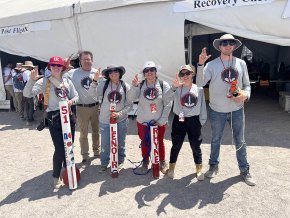
The little rocket team that can
After months of planning, designing, building, testing and sweating, the Lenoir-Rhyne University Ballooning, Engineering and Rocketry Club (BEAR Club) watched their creation shoot a straight line into the clear blue sky over the New Mexico desert and disappear.

As the world’s largest rocketry competition — hosted by the Experimental Sounding Rocket Association (ESRA) at the Spaceport America launch site near Las Cruces, New Mexico — this year the Spaceport America Cup assembled 159 qualifying teams from colleges, universities and technical institutes in 24 countries.
“By enrollment, we were the smallest school that participated,” said chemistry major and team member Erica Schulz ’24. “We met teams from big state schools with huge engineering programs. They’d have 200 people on the team and they bring 40 of them to Spaceport America. We have a team of 8 people and brought five, but it didn't hold us back at all. We still had a beautiful nominal launch.”
In a nominal launch, the rocket comes down in a condition that could be reassembled, refueled, and safely launched again right away — which is how the LR rocket landed, placing the team in the top 47% in the competition’s final rankings, ahead of several prestigious engineering schools and two Ivy League teams.
BEAR Club advisor Doug Knight, Ph.D., associate professor of engineering physics, compares the Spaceport America Cup to the NCAA Tournament, but for interdisciplinary science instead of basketball.
“I consider it a major win if the team finishes in the top half of the competition. It’s like getting to the Sweet Sixteen. We’re one of the smallest schools invited, and we're able to stand side by side with large Division 1 programs. That’s huge,” he shared.
More than a contest
Competition is a small part of the whole experience. Teams exhibit their rockets on the first day, allowing participants to meet and share experiences. That collaborative spirit follows the teams and keeps them helping and cheering for one another throughout the week..
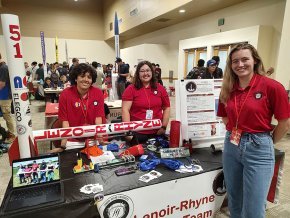
“There’s a feeling that you belong. You get to compete with other people from around the world doing what you love doing, and you talk about ideas that are unique to the competition. These are conversations you will only have at Spaceport America, which makes it special,” shared engineering physics major Caleb Knight ’24.
Participants also network with representatives from the event’s corporate sponsors, including Blue Origin, Aerojet Rocketdyne, Virgin Galactic and a host of other space and technology firms.
“I could see how large and multidisciplinary the world of engineering and tech science really is,” said biochemistry major Emily Asvestas ’26. “Talking to these employers, learning about the variety of jobs that exist, showed me there’s so much I can do with my degree that I never even thought of.”
Teamwork makes the dream work
The BEAR Club’s strength is academic diversity, uniting majors in chemistry, biochemistry, mathematics and engineering physics.
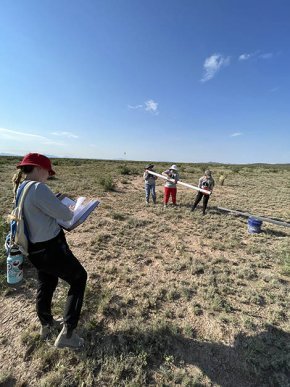
“We each bring something different to the team, which allows us to come up with creative ideas and approaches to rocketry,” shared Asvestas. “We also have a fun and engaging personality as a group, which is helpful because rocketry is hard work. You need everyone pulling together.”
An open membership policy and friendly representatives built this interdisciplinary team, a trend each member would like to see continue in the future.
“I didn’t have any experience with rockets, but I’d always wanted to join. Last spring when they were looking for new people, my friend brought me to a meeting,” shared Christina Fisher ’25, a biochemistry major who took point on the payload experiment required of each entry in the competition.
Demmi Ramos ’25, called working with Fisher a highlight of the competition. “People assume as a math major I’m working on equations and computing, so it was great to get so much hands-on experience with the payload, running with it, and solving problems. It was our baby.”
That team connection got noticed during the competition, according to Schulz.
“Even the judges were impressed with the fact that every single person on our team had a hand in every part of our project. There was not a single part of that rocket that every member did not touch.”
Launching the future
When the BEAR Club returns for 2023-24, they will reconvene with new knowledge and fresh ideas. Caleb Knight will be returning from a summer internship with Aerojet Rocketdyne in Los Angeles. Schulz will commence her senior research project investigating ways to use sugar to fuel a rocket.
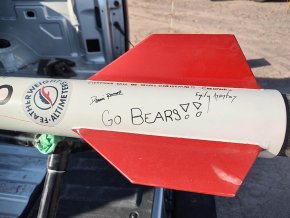
Team members will also have an opportunity to pursue Level 1 rocketry certification — or Level 2 or 3 if the member already has Level 1 — which will allow them to fly some classes of rockets independently and will expand their knowledge base ahead of the next Spaceport America Cup.
Ramos is eager for the new selection of projects. “Next year we’re planning to launch a balloon during the total solar eclipse in April, in Arkansas to get in the path of totality. I’m super excited to be part of the design for that project.”
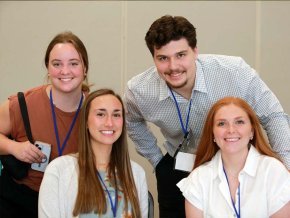
Lenoir-Rhyne University students showcased their academic excellence and research expertise at the 2025 North Carolina Academy of Science (NCAS) annual meeting in late March.
View More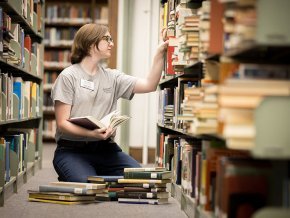
For graduate assistant Lucas Quinn, M.A. '25, Carl A. Rudisill Library is more than a workplace — it’s a space for leadership, advocacy, and community.
View More